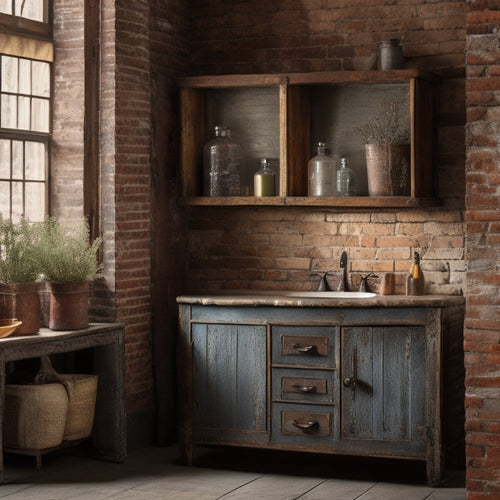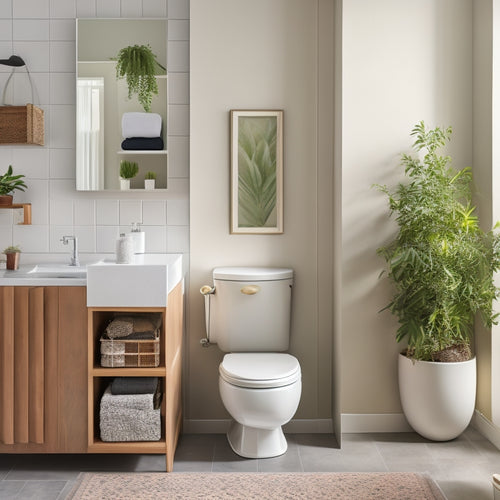
Home Improvement: Organize, Budget, and Plan
Share
To achieve a successful home improvement project, it is crucial to organize, budget, and plan effectively. Start by setting realistic priorities and allocating resources accordingly. Track expenses to guarantee financial goals are met. Implement organizational hacks like chalkboard tracking and DIY storage to streamline workflow and reduce stress. Create a project schedule and conduct cost analysis to optimize time and resources. By following these steps, homeowners can transform their living spaces while staying on budget and schedule. With a clear understanding of these fundamentals, the possibilities for a perfectly planned and executed home improvement project are endless.
Key Takeaways
• Set realistic budgets and priorities to concentrate on the most important tasks and make the most of financial resources.
• Organize tasks and materials using DIY storage ideas, chalkboard tracking, and high-tech tools to streamline project workflow and reduce stress.
• Create a project schedule and conduct a cost analysis to allocate resources effectively and break down tasks into manageable chunks.
• Implement smart organizational strategies and resourceful planning to maximize space and utilize multi-functional furniture and shelving units.
• Establish a well-organized home management system, allocate time and resources effectively, and create a daily schedule to reduce stress and increase productivity.
Setting Priorities and Budgeting
When starting a home improvement project, setting a realistic budget and determining priorities are essential initial steps, as they allow homeowners to concentrate on the most important tasks and make the most of their financial resources. Effective budgeting strategies involve prioritizing tasks, allocating funds accordingly, and tracking expenses to guarantee financial goals are met.
It's vital to distinguish between must-haves and nice-to-haves, focusing on the most critical aspects of the project. By setting clear financial objectives, homeowners can create a detailed budget that accounts for all necessary expenditures. Additionally, tracking expenses helps identify areas for cost-cutting, ensuring the project stays within budget.
Organizing Hacks for Efficiency
Five essential organizing hacks can greatly enhance the efficiency of a home improvement project, from low-tech solutions like chalkboard paint to high-tech tools like project planners and worksheets.
Chalkboard organization is a simple yet effective way to keep track of tasks, deadlines, and shopping lists. Use chalkboard paint on walls or furniture to create a customizable space for writing and erasing information.
DIY storage ideas, such as repurposing old crates or baskets, can also help keep materials and tools organized. By implementing these hacks, homeowners can streamline their project workflow, reduce stress, and stay on track.
With a little creativity and planning, organizing a home improvement project can be a breeze. By incorporating these essential hacks, homeowners can achieve a more efficient and successful project outcome.
Planning for Home Improvement
Effective planning is the cornerstone of a successful home improvement project, and it begins with setting clear goals, determining priorities, and allocating resources accordingly. This pivotal step enables homeowners to create a realistic timeline, manage their budget, and guarantee a smooth project execution.
To plan effectively, consider the following:
-
Time management: Create a project schedule to stay on track and avoid delays.
-
Resource allocation: Conduct a cost analysis to determine the most cost-effective materials and labor options.
-
Project execution: Break down the project into manageable tasks to maintain momentum and motivation.
Maximizing Space and Resources
By implementing smart organizational strategies and resourceful planning, homeowners can maximize the full potential of their living space, making the most of every square foot and dollar invested.
One effective approach is to incorporate resourceful storage solutions, such as multi-functional furniture, shelving units, and hidden compartments. This enables homeowners to optimize their space while keeping clutter at bay.
Additionally, space-saving solutions like foldable tables, wall-mounted fixtures, and compact appliances can further enhance the functionality of a room.
Streamlining Home Management
A well-organized home management system is essential for maintaining a comfortable, efficient, and cost-effective living environment. It enables homeowners to allocate time and resources more effectively, reduce stress, and increase productivity.
By implementing time-saving routines and efficient storage solutions, homeowners can streamline their daily tasks and free up more time for leisure activities.
Here are three ways to achieve this:
-
Create a daily schedule: Plan out your day, including cleaning, cooking, and personal tasks, to guarantee a smooth and efficient flow.
-
Designate a 'launching pad': Designate a specific area, such as a hook or tray near the entrance, for keys, wallets, and other frequently misplaced items.
-
Utilize vertical storage: Maximize storage space in small areas by using wall-mounted shelves, hooks, and baskets to keep clutter at bay.
Frequently Asked Questions
How Do I Handle Unexpected Delays in My Home Improvement Project Timeline?
When handling unexpected delays, conduct a risk analysis to identify potential roadblocks, and engage in contingency planning by allocating a buffer zone in your timeline and budget to mitigate the impact of unforeseen setbacks.
Can I Claim Home Improvement Expenses on My Tax Return?
When filing taxes, homeowners may be eligible for tax credits or itemized deductions on qualified home improvement expenses, such as energy-efficient upgrades or medical necessity modifications, which can help reduce taxable income.
What Are the Benefits of Hiring a Professional Project Manager?
As the project's puzzle pieces fall into place, a professional project manager brings order to the chaos, ensuring project efficiency through meticulous planning and stakeholder communication, resulting in timely completion and cost savings.
How Do I Ensure Compliance With Local Building Codes and Regulations?
To guarantee compliance with local building codes and regulations, conduct thorough code research and navigate the permit process by consulting with local authorities, reviewing ordinances, and submitting required documentation to avoid costly rework and potential fines.
What Is the Best Way to Handle Disputes With Contractors or Suppliers?
When handling disputes with contractors or suppliers, prioritize clear communication to resolve issues promptly. Explore mediation options, such as arbitration or neutral third-party negotiation, to resolve conflicts fairly and efficiently, minimizing project delays and financial losses.
Related Posts
-

Vintage Metal Bathroom Storage for Industrial Look
If you're aiming for that chic industrial look in your bathroom, vintage metal storage is the perfect choice. These p...
-

Over-The-Toilet Storage for Modern Homes
Over-the-toilet storage is a smart solution for modern homes, maximizing vertical space and enhancing organization. Y...
-

Revamp Your Coffee Station With Free Print
Revamp your coffee station with a combination of functional organization and stylish decor. Start by optimizing your ...


